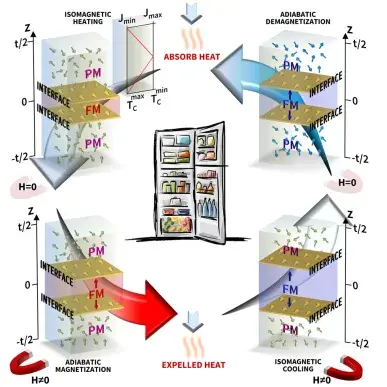Dr. Lorenzo Fallarino has been recently nominated as Emerging Leader in Applied Physics
Dr. Lorenzo Fallarino, researcher in CIC nanoGUNE´s Nanomagnetism group, has been recently invited by the Editorial Board of Journal of Physics D: Applied Physics to publish a Topical Review on "Graded Magnetic Materials" and separately, he was nominated to contribute to a special issue of the journal highlighting the accomplishments of Emerging Leaders in the field of Applied Physics. Both invited articles have now been published.

Graded magnetic materials are systems exhibiting spatially dependent magnetic properties, showing improved performances for many technological applications. It is interesting to realize that the main idea behind such structures has its origin in nature, where graded materials are commonly found in bones, teeth, skin, biological tissues, or plants. Dr. Lorenzo Fallarino, together with other members of the Nanomagnetism group at nanoGUNE, has created artificial structures that brought the graded materials concept to far smaller length scales than can be found in nature all the way to the (sub) nm-scale, by means of creating designer profiles along the growth direction of ultrathin magnetic films. This approach has now been comprehensively described and reviewed in “Graded Magnetic Materials”, a topical review article that reports on the most recent advances in this emerging research field, hereby reviewing numerous experimental attempts to create graded magnetic films, multilayers, and materials in general.
In addition to the scientific interest of understanding these designer materials, their anomalous magnetic properties also translate into improved performance characteristics, as reported in “Nanoscale control of temperature operation ranges for magnetocaloric applications”. This invited article describes how these graded materials can be utilized to achieve large magnetocaloric effects over wide temperature ranges. The magnetocaloric effect describes hereby the temperature change of a magnetic material upon the application and removal of a magnetic field. It can be seen from Figure 1 that, by operating the graded magnetic materials in four steps, it is possible to expel heat and produce cooling, such as in a Carnot refrigeration cycle. This so-called magnetic refrigeration has significant advantages over the commercially available gas-compression refrigerators, both economic and environmental, but will be reliant on novel and improved materials, such as the graded magnetic materials developed by Lorenzo Fallarino and co-workers at CIC nanoGUNE.
Lorenzo Fallarino et al 2021 J. Phys. D: Appl. Phys. 54 303002
Nanoscale control of temperature operation ranges for magnetocaloric applications
Juan Sebastián Salcedo Gallo et al 2021 J. Phys. D: Appl. Phys. 54 304003
